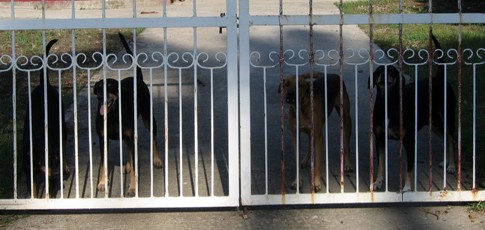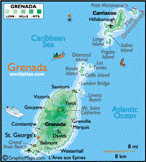For those of you
who are unfamiliar with the island of
Grenada, this page serves as an introduction to where we are and how
our experiences are a bit different here. The
country of Grenada consists of three main islands: Grenada, Carriacou
and
Petite Martinique. The islands
lie
approximately 100 miles north of Venezuela, around 12 degrees north
latitude. Grenada dwarfs the other two islands, coming in at an
impressive 21 miles by 12 miles. Grenada is hilly and
mountainous, reaching heights of 2,750 feet above sea level.
North of us is St. Vincent and the Grenadines, and to the south are
Trinidad and Tobago.
Grenada is known as "The Spice of the Carri bean"
because there are said to be more
spices in Grenada per square mile than anywhere else on the
planet. Nutmeg is the most abundant spice - Grenada produces a
third of the world's supply - and cinnamon, ginger, and vanilla are
also common. St. George's is the capital of Grenada. St.
George's University, or SGU, is located about ten miles from the
capital city. The SGU campus occupies a hill at the end of a
peninsula. The area is gorgeous: the views are amazing, the
breezes feel wonderful, and the campus itself is beautiful.
The average temperature ranges from 75 degrees to
85 degrees. It
is often breezy, which is very pleasant. We are currently in the
rainy season. When it rains, it does so only very briefly each
time - which is similar to what we had become accustomed to in
Boulder. However, it rains often and when it rains, it pours! The sky
seems to open up and water absolutely gushes out. Then it is
clear and sunny again - it does
not seem to rain for more than an hour at a time. It is, of
course, very humid, but most locations enjoy wonderful breezes.
Many homes and businesses have
porches or open-air areas with roofs where people can congregate or
eat, which is so
wonderful.
We understand that the tourist season begins in late fall. Grand
Anse beach is a gorgeous beach with bright white sand which seems as
soft as flour. Since it is on the leeward side of the island,
there are very few waves at the beach. The water is clear and
warm, and snorkeling right off the beach reveals a wealth of fish
life. Grenada is, or was, known for its large, branching corals,
but many
of them were destroyed in Hurricane Ivan. Nevertheless, the
marine life is still quite abundant and interesting - from crabs that
we have never seen before to eels and squid and tropical fishes.
We have a new conscientiousness about what we eat
and where. Food
items have a new
category here - they are assessed particularly for crumbliness and
sweetness. No remotely crumby or sweet items are strictly
There are insects ready to take advantage of any
little crumb or spill. Careful cleaning and (horror) chemicals
seem to be a must.
The Grenadians
and students alike are very friendly and
kind. If you just say hello, and how are you doing, many a
Grenadian
will stop and exchange a brief conversation before moving on.
Over 101,000 people inhabit Grenada, including 8,000 in Carriacou and
600 on Petite Martinique. Seventy five percent of the population
is of African descent, with many of East-Indian and European roots
also. Grenada is English speaking. However, we have found
it sometimes
difficult to communicate with the local Grenadians as their English can
truly sound like a different language. When they speak, it is
much more melodic and pleasant sounding, but strangely hard for us to
follow just yet.
Although we were told not to bring much nice clothing, the local
population dresses in very nice and crisp clothing - often in long
pants or skirts and button down shirts. Children wear beautiful
uniforms to school, and on
Sundays, the children are a sight to behold as each one is
dressed in their most stunning Sunday best.
The island of Grenada is host to
many feral dogs and
cats. The campus is a haven for feral cats, as the dogs must have
been driven off of campus long ago. The feral dogs are everywhere
else. Many Grenadians have dogs, but dogs
appear
to occupy a very different niche here than in the states. So far
that we
have seen, dogs that have homes live outdoors. Often many dogs
live at one
home, four to six is not uncommon. Most homes (with or without
resident dogs) are fenced and
gated - often both around the property and around one's porch. We
live in an apartment which is the lower level of a Grenadian woman's
home, Christine Antoine. She has four large dogs, two are older
(over ten years old) and two are younger
- one of the younger ones is a bit "gimpy," and the other, Ginger, is
brown and a hurricane Ivan rescue dog from the former next door
neighbor. The dogs seem well
fed (unlike the homeless dogs) and not mistreated, but they are
exclusively outdoor dogs and
full of fleas, not to mention that they behave a bit oddly. They
bark ferociously
at any passerby and particularly at people approaching the
property. However, if you ignore them, open the gate, enter,
and walk
toward the house, their fearsome barks cease altogether and they keep
their distance. Despite their bark, they are very wary of
people. Only after a week was Heather able to pet one dog's head
- the
gimpy one. One of the old dogs let himself be touched (barely)
after about three weeks. The local people say that they like to
have dogs
because the dogs alert them when other people are around. It all
seems very strange to Heather! There
is an SPCA in Grenada, and if Heather can figure out how to get there,
she will likely get more involved.
 The fellas. They are much
less ferocious to approaching Heathers now! The fellas. They are much
less ferocious to approaching Heathers now!
The local unit of currency is the "E.C." or
Eastern Carri bean
dollar. One U.S. dollar is $2.67, which does not buy much as most
goods and foods are very expensive. Services, however, are very
cheap. Many people have maid, landscape and maintenance or
childcare "helpers."
Although Heather
looked forward to getting away from the "car
culture" of America, this has been a bit of a disappointment!
Walking is feasible during the day, but pedestrians must tolerate very
fast drivers on rather narrow roads. We are getting around
reasonably
well on
foot and on the University bus system, but we have not been able to
explore much of
the rest of the island, including the
capital. Cars zoom around everywhere. Drivers,
theoretically,
drive on the left side of the road here, but practically speaking, they
drive wherever they choose until a car comes at them from the other
direction; then they tend to scoot over to the left at the last
moment. They pass one another on the right quite wildly, giving a
little toot of the horn as they do. They also toot their horns if
a
car in front is going to slow, if a taxi or "reggae bus" is coming up
from behind and offering you a ride, if they see someone they know, or,
it seems, if the wind just changes direction! Many vehicles, and
especially the local taxis, play loud fast-paced music. During
the
week of carnival, every vehicle played a fast paced reggae music
similar to Brazilian carnival music, but now the buses play a wide
variety of music.
|

 The fellas. They are much
less ferocious to approaching Heathers now!
The fellas. They are much
less ferocious to approaching Heathers now!